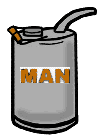|
Past Preventive Maintenance columns: Remembering
Why It Is Important to Perform PMs Leveling—Machining
Centers and Mills Leveling—Is
It an Issue After Installation? Frequently
Asked PM Questions Machining
Center PM—Index and NC Tables Examining
Accuracies on Machining Centers Zero
Points on Machining Centers—Machining Centers vs.
Lathes Completing
Lathe Maintenance—Tailstock, Sub-Spindle, and
Zero-Point Alignment A
Closer Look at Spindles and Turrets The
Next Level: Accuracy—Checking Backlash on Lathes
Inspecting
the Electrical Cabinet Everyone's
Favorite Task—Cleaning Coolant—The
Most Ignored Fluid in your Machines It's
Summertime—Is your Chiller Working? The
Other Oils—Inspecting the Main Hydraulic Systems
|
MIKE BREEN ON PREVENTIVE MAINTENANCE |
|
PM on Grinders — by Michael W. Breen |
|
|
Cleaning Machines As always, when performing a PM, cleaning is a priority. Instead of chips, you will find “swarf.” Swarf is a combination of grinding wheel composites and whatever material you are grinding. It normally is not difficult to clean unless it hardens. If that happens, get your chisels out. If you are using cutting oil, and there is a buildup of swarf, the chance for fire increases because sparks are common in grinding applications. For example, years ago, when I was an internal maintenance technician, a machine crash occurred. The ID wheel head, which was turning at a ridiculous rpm, crashed into the part. The grinding area was completely enclosed, making it very hard to clean. Sparks flew everywhere, and the build-up of swarf caught on fire. The operator quickly doused the flames with a fire extinguisher; and, even though the machine was not a total loss, every cable and line in the work area required replacement. It was our belief that the buildup of oil-soaked swarf around the workholding spindle was the cause. The sparks from the crash had to go somewhere with their extra momentum. If there had not been a buildup of swarf, the sparks would have been doused immediately in the flow of cutting oil. So, you can see why cleaning is a priority. Cleaning the coolant sump is equally important. Many of the better-designed systems will filter the swarf before it enters the sump. Remember that swarf is very abrasive and will eat away everything in its path. It really savors coolant pump impellers. I think my point has been made. At this time, the filter operation should also be checked. Checking the Spindle Like the machines we have discussed in past months, the spindle is also a priority on grinders and must be looked at. Grinding tolerances are usually much tighter than milling or drilling applications, and the finish is expected to be perfect. There is some extra work involved in this procedure. In most styles of grinding spindles, you cannot check the spindle with the grinding wheel mounted. Carefully remove the wheel and store it on a wheel rack. If the wheel is dropped or nicked at all, the wheel must be tested. The spindle should be warmed up prior to testing. To check spindle runout, mount a micron or 0.0001" per increment indicator about midpoint on the side of the spindle taper. Zero it out, and rotate the spindle. Do not rotate the spindle by hand. The force of your hand will cause the spindle to move in other than a rotational direction and give an unusable reading. If you do not have a spindle jog option with your machine, you have to program a slow rpm command. If the program is too fast, you will not be able to get an accurate reading: the spindle only needs to make a couple of revolutions to test. In our machines, the runout cannot exceed 0.0001". Remember: this is only a PM, and replacing the bearings on the spindle or the spindle shaft itself involves very meticulous procedures. Checking the endplay of the spindle will require the same style of indicator. The indicator tip needs to be placed on the end of the spindle. We usually use a greased ball from a bearing and mount it on the end of the shaft in the center hole in the center of the shaft end (the center hole is a result from the spindle shaft machining process). Then, place the indicator on the tip of the ball. Again, run the spindle at a low rpm. Runout should not exceed more than 0.0002". We are not done with the spindle yet; so, next time we will complete the spindle and hopefully dig into hydrostatic ways. Talk to you next month. Mike Breen’s career of more than 14 years in machine tool repair includes his experience as an aircraft electrician in the U.S. Army’s 101st Airborne. As a Certified Electronic Engineer, he presently is working as a Field Service Engineer with Ellison Machinery Company of Wisconsin. Mike has held this position for more than six years, during which he has designed and implemented complete preventive maintenance programs for many successful companies. He invites you to share your own machine repair and maintenance experiences with him. For comments and inquiries about these articles, his e-mail address is mbreen@ellisonwi.com. - September 2001 |

 We are switching gears this month, or should I say wheels, to talk about PM on grinders.
We are switching gears this month, or should I say wheels, to talk about PM on grinders.